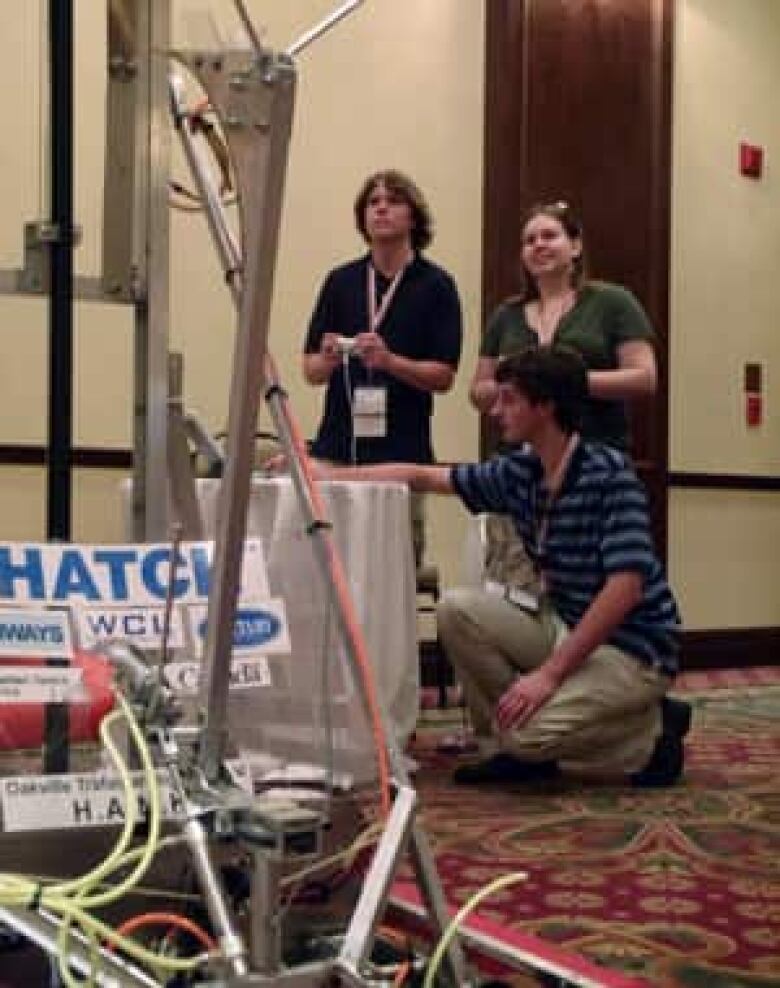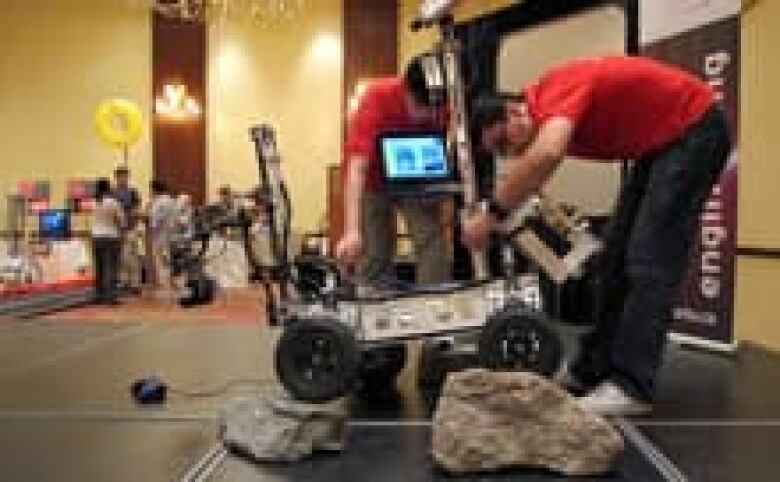Student-built robots vie for Canadian innovation prize
Students compete in the Innovation Nation Robotics Competition
Six teams of competitors go sensor-to-sensor in Huntsville, Ont. on Tuesday in the Innovation Nation Robotics Competition.
The entrants include robots for mining on the moon, a guide wand for the visually impaired, a multipurpose rover and a miniature car and two robots designed to compete in a game.
Student teams from Canadian high schools and universities are eligible for the competition. First prize is $5,000.
Winner selectedJuly 19 -The Oakville Trafalgar High School robotics team won the Innovation Nation robotics competition. |
Although Canada is considered one of the top countries for robotics, especially space robotics, it has slipped in the last two decades, according to Anvari.
Laurentian's moon miner
One of the competing teams is already a winner.
The team from Laurentian University in Sudbury, Ont.,won NASA's Lunabotics competitionin May, beating out international rivals. Their lunabot, which was in development for nine months, was judged the best for mining lunar regolith, a loose layer of material covering solid rock. Team member Greg Lakanen, who is in Huntsville for Tuesday's contest, told CBC News that their lunabot was "designed and built to compete in the NASA competition."
That was their first robotics competition. The victory was particularly sweet because the eight team members are part of Laurentian's first graduating class in mechanical engineering.
This time they are up against teams with robots built for different purposes in a contest that showcases what young Canadian innovators are able to do. Win or lose, Huntsville is the last stop for the lunabot before it goes on display at Science North in Sudbury.
Abbey Park High's guide wand
The robotics team from Abbey Park High School in Oakville, Ont. has designed a sonic guide wand as their entry for thecompetition.
The wand uses electronic sensors to alert its user to the presence of objects and changes in terrain. For the visually impaired the white wand would be an alternative to the white cane, according to team member Garnet Mason. Mason told CBC News that the guide wand would also give users information on a much wider range than the cane, which relies on sense of touch.
Compared to other electronic canes already on the market, Mason said their wand will be smaller and use more sensors.
Robots that play games
Two teams have entered robots designed for this year's game in the major and long running international robotics competition known by its acronym,FIRST (For Inspiration and Recognition of Science and Technology). The game is called logo motion and the object is for the robot to pick up and place differently shaped inner tubes on hooks at different heights on a scoring rack.

Our Lady of Lourdes Catholic High School in Guelph, Ont. has Robot.I.Am and Oakville, Ont.'s Oakville Trafalgar High School team takes the name of the school's sports teams, the Red Devils.
Evelyn Wainewright from OakvilleTrafalgar's team told CBC News that their Robot, HANK (Harbinger of A New Kool), could be easily modified for transporting materials in a hospital or warehouse setting.
Wainewright, who is moving on to study robotics at Mount Allison University in Sackville, N.B., said HANK was first designed using SolidWorks modeling software. She estimates the cost of running the robotics team at $35,000.
The other competing robots come from Seneca College and York University in Toronto.
Seneca's entry is a miniature car that operates on an eco-friendly automated transportation system.

York's entry is a rover prototype named Helios. In both 2010 andthis year in Hanksville, Utah the team placed secondin the Mars Society'sUniversity Rover Challenge, using different rover prototypes.
Winning isn't everything
The entrants that CBC interviewed for this story pointed out that one reason to enter the competition is for the learning and mentoring opportunities it presents.
And Anvari said that is indeed one of the reasons for the competition. He explained that most of the judges are experts in the field and they will be giving feedback. "We will give them input advice on how to take that idea to the next level," he added, noting that one judge is a lawyer with expertise in that area.
The judges will be looking at how applicable the device is for everyday use, its novelty, how well it's presented and the teamwork for the project. Anvari said he hopes the winning robot "has potential for becoming a commercial product."












_(720p).jpg)


 OFFICIAL HD MUSIC VIDEO.jpg)
.jpg)



























































































